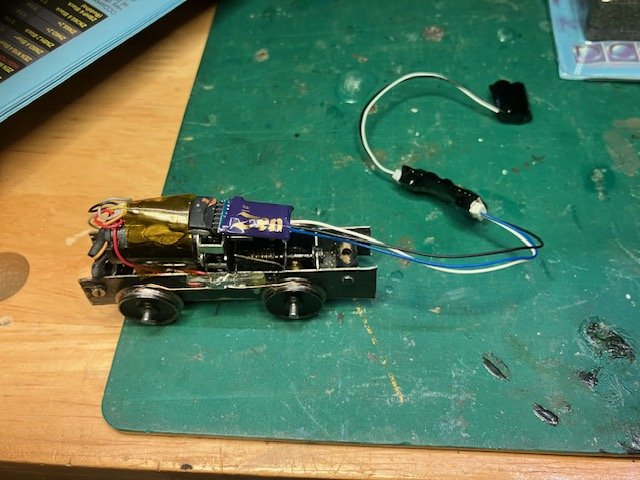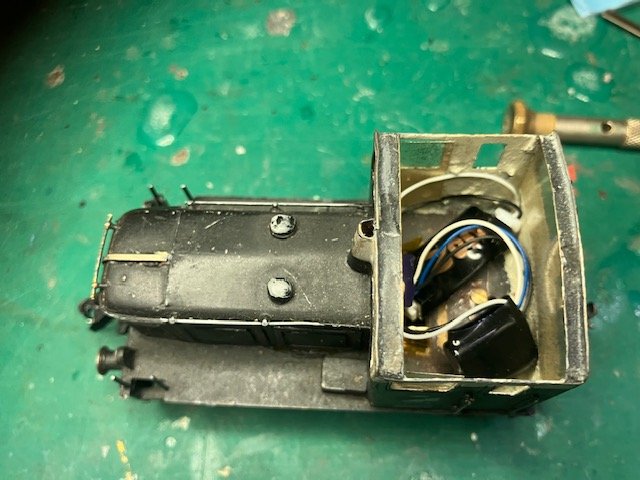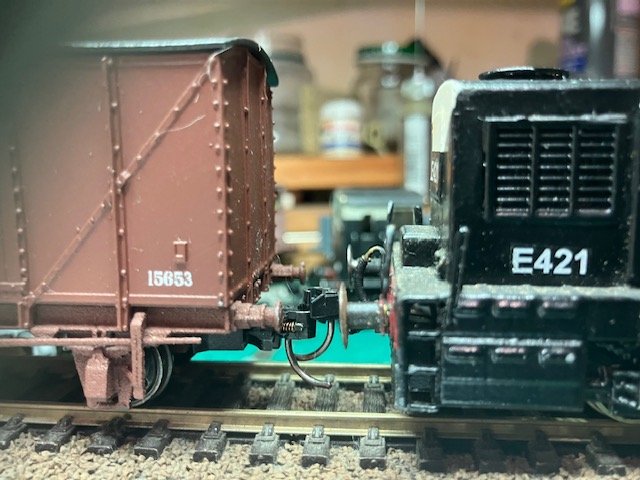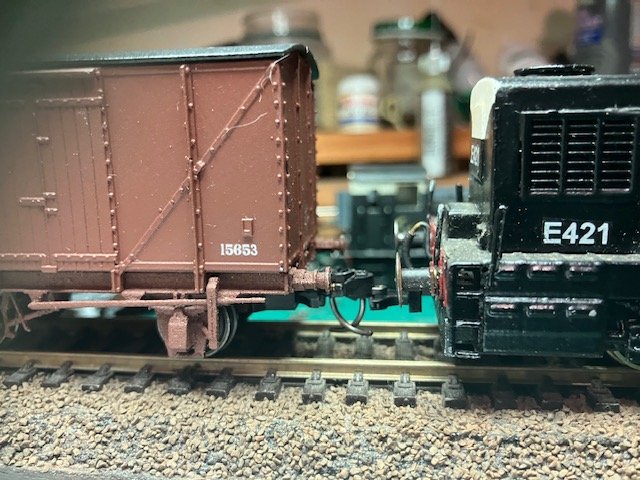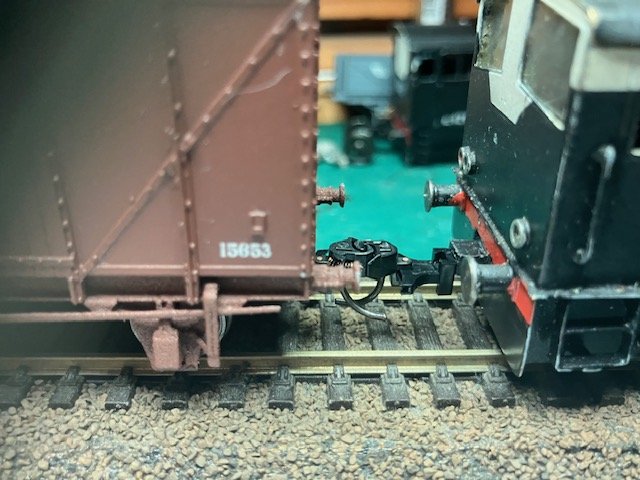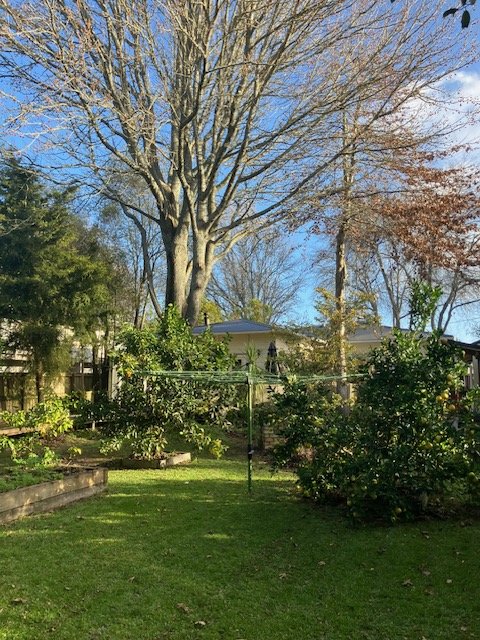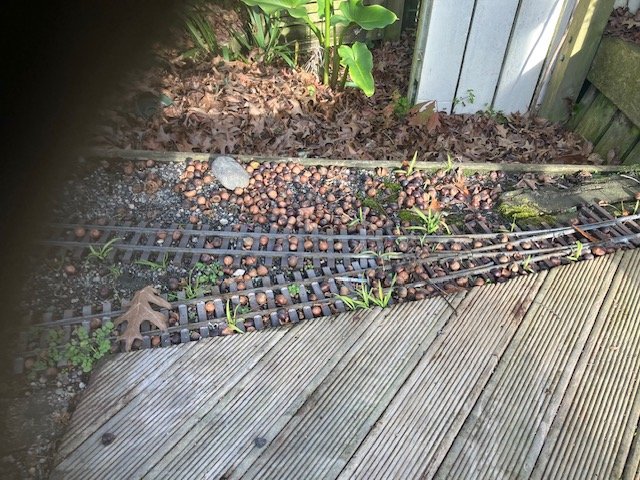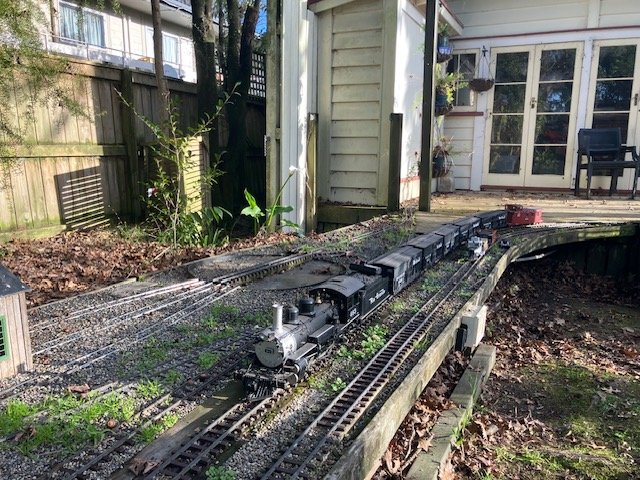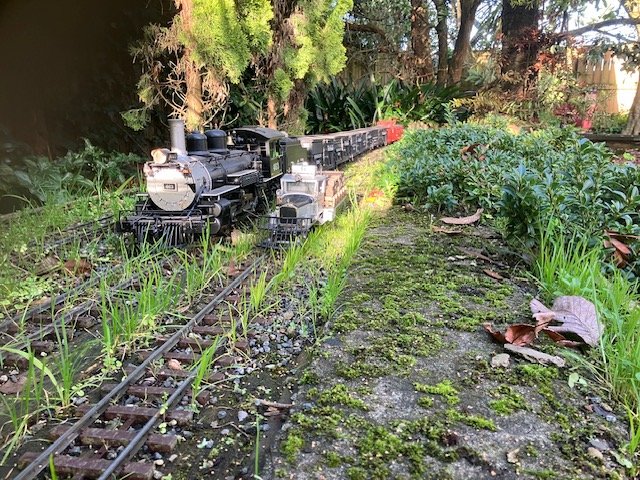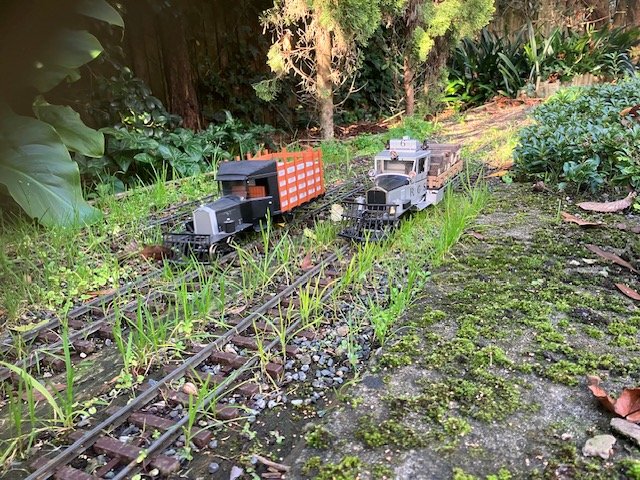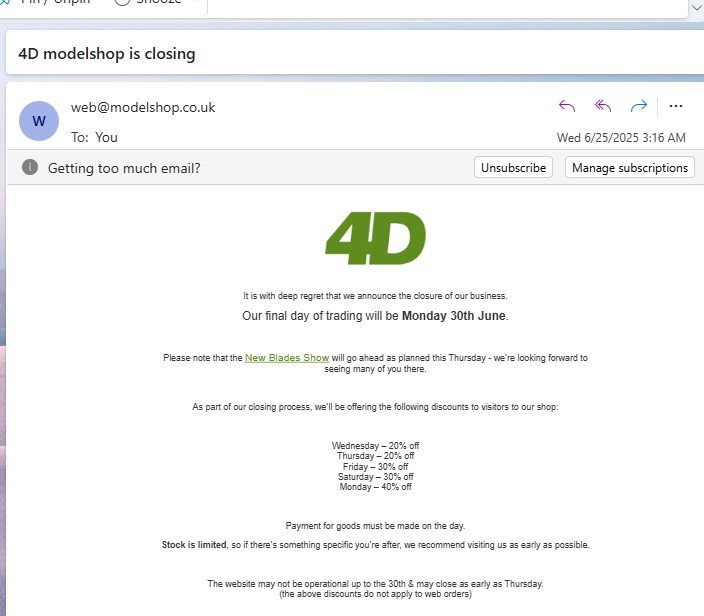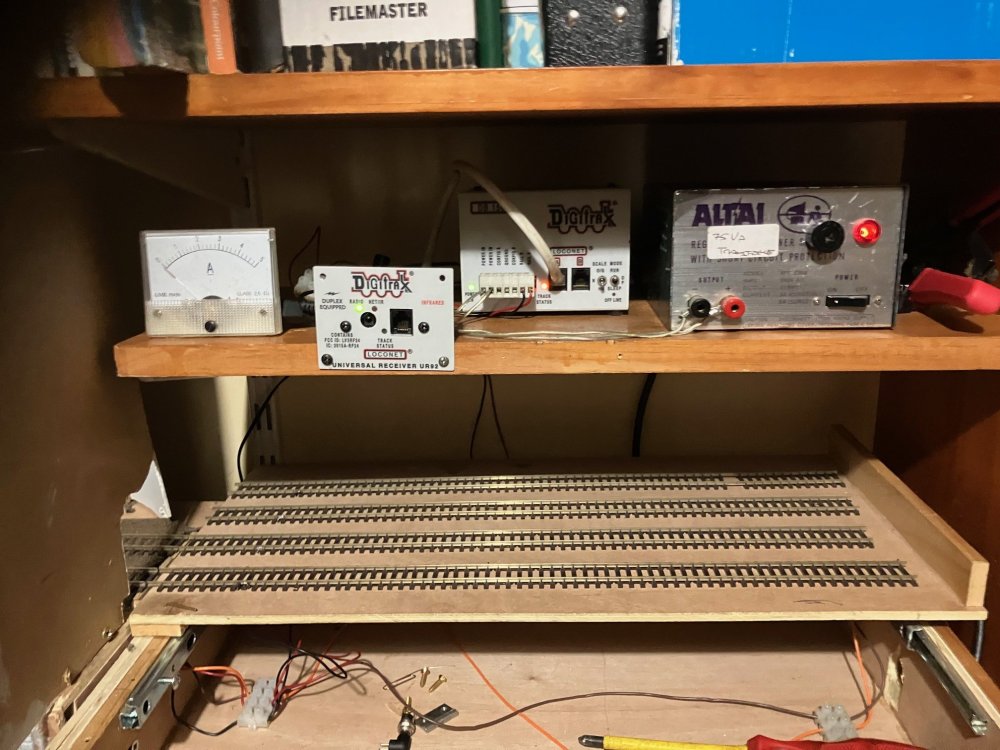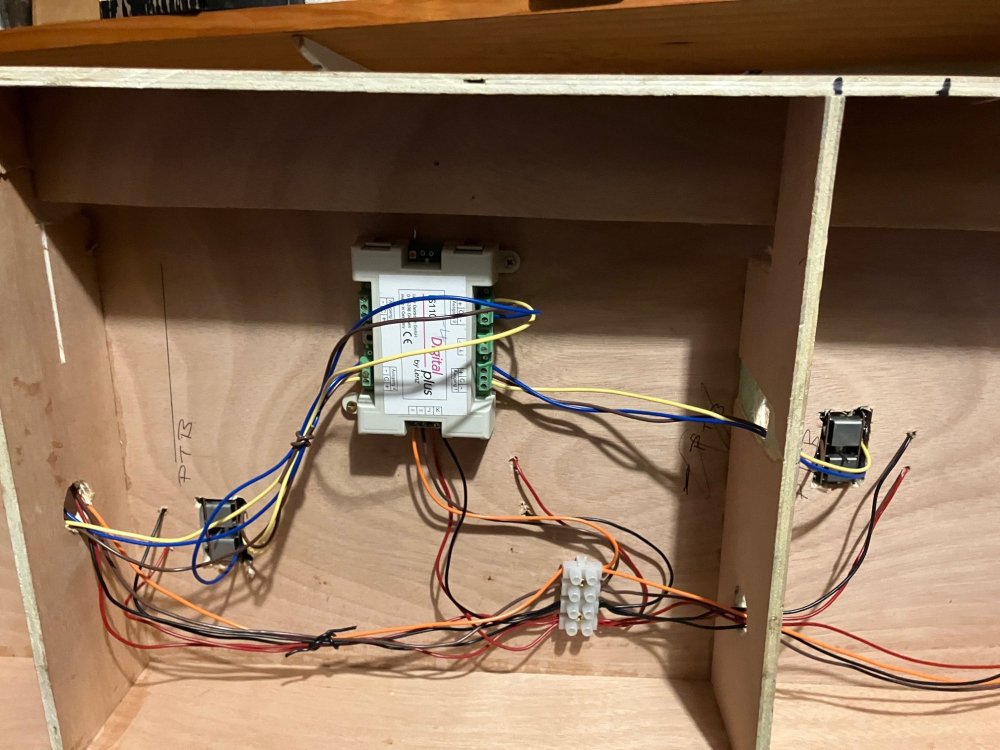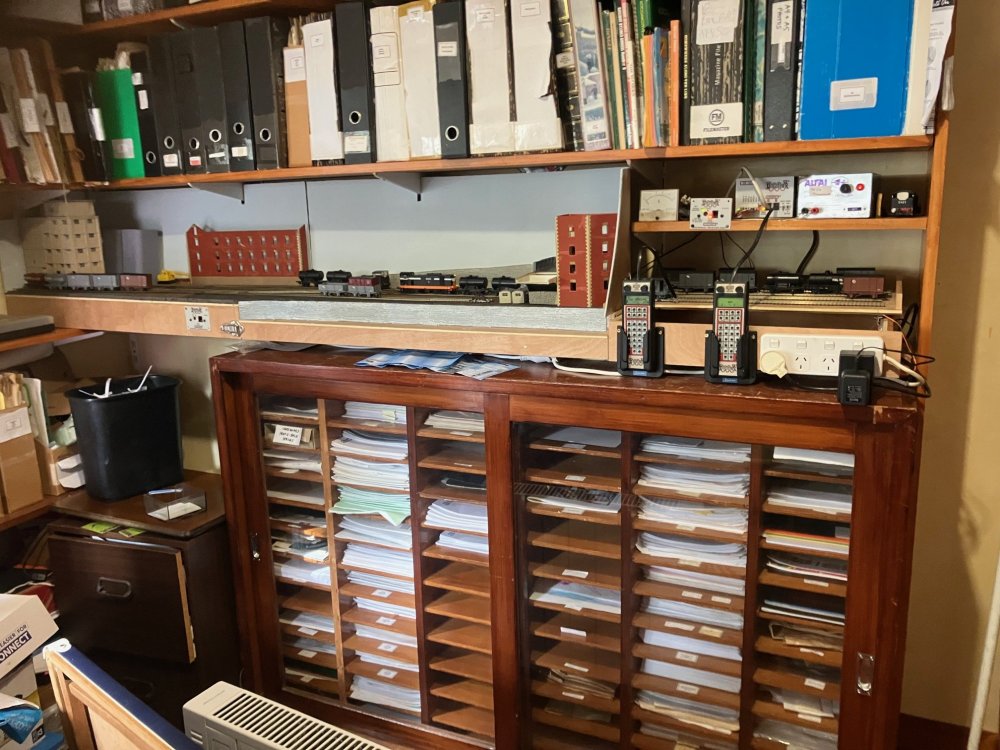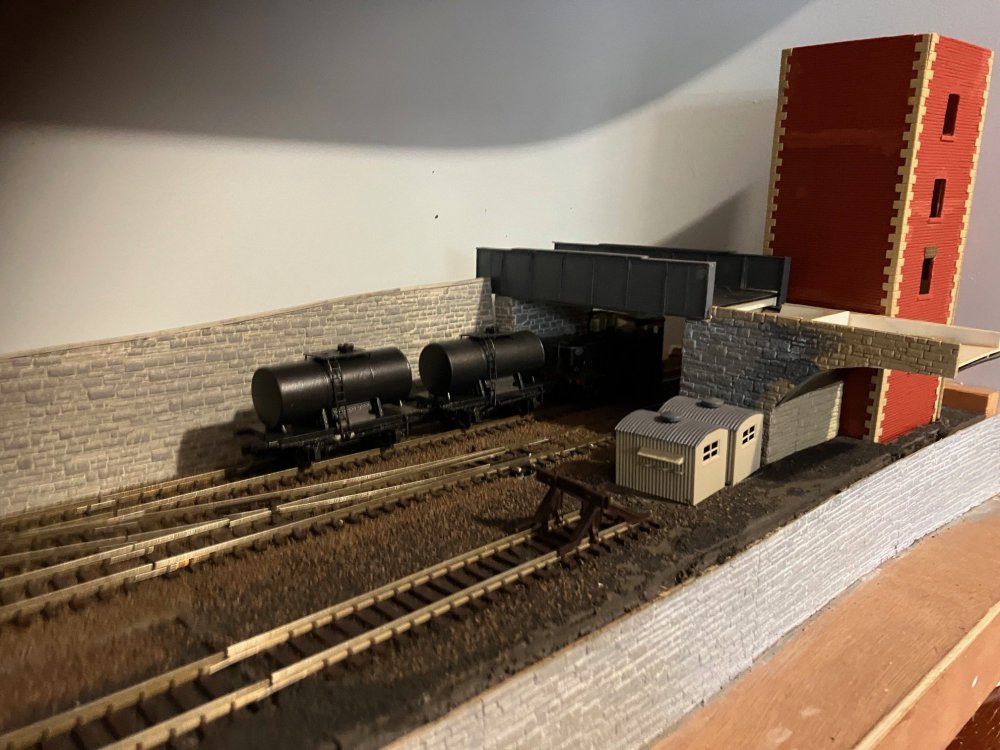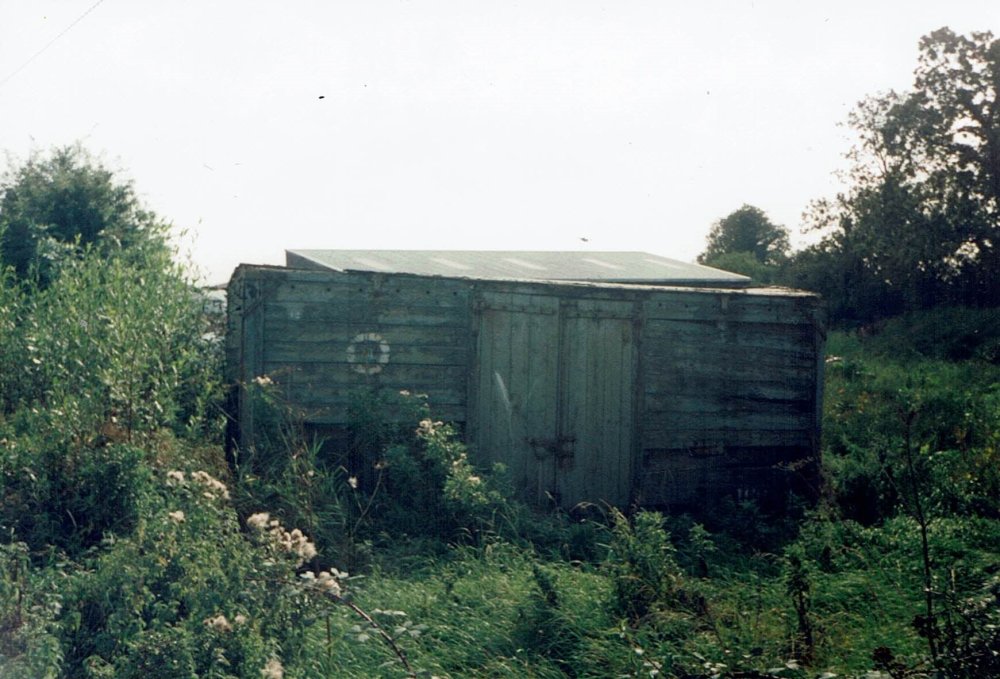-
Posts
4,878 -
Joined
-
Last visited
-
Days Won
119
Content Type
Profiles
Forums
Events
Gallery
Everything posted by Mayner
-

(Almost) Brand new out of the box. Class 93 Tri-mode on test
Mayner replied to leslie10646's topic in Irish Models
When I first read your Post I thought you were trying to flog off a 'recently un-boxed " Trix AL1 electric loco. https://www.vectis.co.uk/d049-lot-994495-trix-trains-2-rail-1128-bo-bo-br-blue-class-al1-overhead-electric- 5 replies
-
- 1
-

-
- railway operations group
- class 93
-
(and 1 more)
Tagged with:
-
Although fitted with a 'stay alive" (bought several years ago) G617 sometimes stalled on Insulfrog points, so decided to fit the loco with an updated version of DCC concepts 'stay alive' system with a 3 wire medium stay-alive with a separate control unit. Existing Zen decoder and 2 wire hardwired stay alive Mechanism fitted with Zen decoder with 'plug & play' medium stay alive and control unit In order to convert to DCC I fitted the loco with a 6Pin decoder socket & DCC harness mounted on top of the motor. I test run the chassis and programmed decoder CV25 -2 for "Light Freight" before I fitted the loco body the stay alive and wiring are just about below window level and not really visible with the roof fitted. Coupler height needed to be sorted with E421 and G617 to achieve reliable operation. Apart from a slot for a screw or 3 link coupler there was no provision for fitting a proprietary coupler when I originally assembled these locos several years ago and I cut the holes for NEM coupler pockets at an incorrect height! Unfortunately due to the lack of space the coupler pockets on G617 project past the buffer beams which results in a greater distance between the loco and wagons than B125 and E421 To overcome the problem I replaced the existing Kadee#19 couplers with adjustable height #53 couplers. Both locos now couple reliably! SSM are supplying replacements for damaged decals on both locos and hopefully I will complete paint touch-ups and fit glazing to E421. I will probably use E421 to replace B125 for Trip/Main Line work with the G Class shunting the yard and off-scene oil/tar depot/industries.
-
Leaf fall from our largest trees (oak & liquid amber) has just about ceased after 3 months and time to shift the remaining leaves and debris to mulch beds around the garden. Have basically been blowing/collecting leaves since the beginning of April Liquid Amber (left) and oak (right) planted as a sapling in 2008! There is also a large oak on the roadside at the front of our house, which basically covers the garden at the front of our house and roof in leaves. Along with the leaves the Oak creates lots of nuts which collect in the 3' and on our deck and trackbase. One of our first sunny days after a week of heavy rain was a good excuse to run some train to check the line before running live steam. High humidity and rainfall makes the Waikato an excellent place for growing grass, dairy farming and rather surprisingly producing tea and wine. I basically need to bring out the weedkiller to keep vegitation under control! The day was also an excuse to bring out the refurbed Bachmann Railtruck, parts of which in-real life were incorporated into Motor #6 on right. 70 years later an enthisiast Karl Schaffer created a replica of the Railtruck for display at the Ridgeway Railroad Museum. Its just about possible that Motprs #1 & #6 may be seen together as they are both preserved in working order in Colorado.
-
4W Vans include Heating and Luggage Van or "Tin Van", Luggage Van or "Hooded Van" and PO Van/"Heuston Tool Van" Our prices for UK customers are inclusive of VAT as the etches are supplied direct from our engravers in Scotland, prices for customers outside the UK exclude VAT Shipping is usually Royal Mail Registered Post, I can confirm total cost including shipping upon receiving an expression of interest, lead time from placement of order to shipping usually 4-6 weeks. The Van Roofs are supplied as a separate etch and I am considering the option of producing a 3D printed roof as forming an elliptical roof may be challenging for some modellers. I am also considering making detail parts such as buffers, oil tanks and axleguards available as 3D printed parts. Prices: UK customers Van etches £35.00 Roof etch £16.80 Non-UK customers Van etches €38.00 Roof etches €17.00 Heating & Luggage Luggage Van PO Van The etched van parts include two sets of sides to cover a number of in-service modifications. Panels with windows were replaced with plain panels on some heating and luggage vans. Some PO Vans were converted to Tool Vans after the vans were withdrawn from mail service. MGWR Horse Box and Meat/Fish Van These items of Non-Passenger Coaching Stock remained in service on CIE until withdrawn in the late 1950s, there is even a photo of a Meat Van and a 1880s MGWR 6 w TPO coupled between a Tin and a Hooded Van on the Sligo Night Mail Some of the detail castings incl. buffers axlebox/springs and syphon roof vents may be available from the Dart Castings MJT range, I may make the handbrake wheels and Meat Van end posts/louvres available as 3D printed items. (The MGW van frets include a roof!) Prices: UK customers MGW non-passenger stock etches £25.00 Non-UK customers Van etches €29.00 MGWR Meat-Fish Van MGWR Horsebox
-

Heritage Railways in the Republic of Ireland
Mayner replied to Celtic_transport's topic in General Chat
While the WSVR certainly ticks the box in terms of a populous and busy local market, though the founders of the Cavan & Leitrim have managed to re-open a section of the original line and restore a couple of steam locos in a much sparsely populated area largely as a result of the dedication of the companies founders and its supporters group. As Chris pointed out there are a hell of a lot more Heritage Railways some of which only operate 1-2 monthly in New Zealand a country with a similar total population to the Republic spread out over a land mass of similar land area to the UK. Our local heritage line the aptly named Bush Tramway operates over 3-4 miles of line in sparsely populated Bush west of Huntly a small former coal mining town (with its own heritage museum) about 60 miles from Auckland (similar pop to Dublin) and 18 miles from Hamilton (similar pop to Limerick). The Bush Tramway now operates once monthly although at one stage only operated in the Winter/Spring months due to high fire risk during summer and autumn. By a rough count New Zealand has 28 operating Heritage Railway and 4 Main Line Steam/Tourist train operators which break down fairly evenly between the North Island (76%) and much less densely populated South Island (24%). Apart from a handful of heritage lines that operate daily or weekly the majority operate 1-2 monthly or less frequently. Another feature is that our 3 major cities each have a transport/local history museum/historic park which features an operating railway and section of street tramways. https://www.fronz.org.nz/railway-tramway-attractions I guess a higher proportion of people in New Zealand compared to Ireland are interested in railways and more significantly are prepared to contribute financially and physically to heritage railways and museums. -
Received an e-mail that 4D planning to resume their workshop services including etching in a few weeks.
-
Scene of cattle being loaded on to a train at Cork Goods 1975 10:39 of video. Interestingly cattle truck seems to be a 2 axle Hino with a drawbar trailer with cattle unloaded in the yard and allowed to walk to the cattle bank. A Ford D, Bedford TK, Dodge K1050 were popular medium size trucks of the time. Cattle traffic on CIE ceased in late 1975
-

Heritage Railways in the Republic of Ireland
Mayner replied to Celtic_transport's topic in General Chat
I can only speak from my experience as a member of the Welsh Highland Heritage Railway in the UK, the railway was required to establish an Accredited Museum (with appropriate facilities) separate from its heritage/tourist railway operations in order to resister as an Educational Trust for tax purposes. The museum in a purpose built about 20 years ago as annex to the existing Carriage Shed focused on the history of the transport of slate by rail from the quarries to the quays at Portmadoc and included a combination of static and mobile (some on loan from the Festiniog) exhibits. Presumably the Trust would have been able to claim tax relief on donations towards the cost of constructing, operating and maintaining the museum. Interestingly the WHHR markets itself as a short-train ride which included a museum visit (the train guard usually acts as museum guide. The main benefit of the museum is that it increases the time spent by visitors on site and the likelyhood of them spending more time in our shop or cafe potentially increasing our visitor income. I guess at the end of the day the question is whether the effort and expense of maintaining a museum is worth while on an operation like the WSVR when it may be more worth while to increase turnover through shop and cafe sales. -
Just received an e-mail that 4D Model Shop the firm that produced the etch parts for Paul's E401 Class is closing on 30 June. I guess final chance for anyone to place an order for a CIE E401 Class shunter
-
I am planning to supply Coaching Stock etches to order direct from our photo engravers in the UK beginning with our CIE 4w Van and MGWR Horse Box and Meat Fish Van etches and expect to have an updated price list during the next two weeks. I am considering producing sets of etched parts for 1951-53 Inchacore built coaches previously supplied as overlays for converting Dapol/Airfix 60' Stanier coaches to CIE stock. The proposed sets of parts similar in principal to Worsley Works/Comet coaches, supplied with an etched roof to be formed to profile by the builder. At this stage I am looking at producing Buffet Car, Brake Second and will produce further sets of parts if there is sufficient interest based on enquiries for a minimum of 10 of each type of coach.
-

Heritage Railways in the Republic of Ireland
Mayner replied to Celtic_transport's topic in General Chat
Interestingly there was a feature on the Tv the other night about the Glenbrook Vintage Railway (near Auckland) is running a train (steam and diesel hauled) to Palmerston North (over 400km) for this years Matariki (Maori New Year) Festival https://www.facebook.com/glenbrookvintagerailway/ the hosts Steam Incorporated near Wellington proudly pointed out that this would be the first time that trains would be crewed by heritage railway personnel (presumably with a Kiwirail pilot). -

Heritage Railways in the Republic of Ireland
Mayner replied to Celtic_transport's topic in General Chat
In was estimated in 2001 that £ 10 million was required to establish the proposed National Transport Museum at Mullingar Station. https://www.irishtimes.com/news/preservation-is-train-of-thought-in-mullingar-1.334938 . Apparrently it was expected that Central Government & possibly EU would fully fund the project, the article speaks about the Muesum Group expecting to meet the Minister of Arts, Culture, Gaeltacht and the Islands to request £1 million in funding for immediate conservation work (urgent repairs). It looks like the museum was proposed by a local group which may not have given up on the hope of establishing a museum despite serious setbacks https://www.westmeathexaminer.ie/2014/03/19/dreams-of-a-rail-museum-in-mullingar-dealt-a-blow/ I wonder are the museum group still about or have considered other sources of fund raising? -
Looks very neat Alan and should be robust enough for exhibition use. I use a similar concept for aligning the traverser on a OO layout and turntables on my large scale garden railway using 1mm bore brass tube & 1mm brass wire (formed into an L shape) as the bolt/alignment pin. The brass sleeves are bored vertically (a tight fit) into the traverser deck and frame and soldered to rail web on the turntables which at this stage have stood up to 15 use with quite heavy locos, though I have to occasionally replace the odd pin. I was able to set the drawer runners on the traverser vertical having an 80mm baseboard depth.
-

Heritage Railways in the Republic of Ireland
Mayner replied to Celtic_transport's topic in General Chat
I guess the critical difference between preservation attempts in the Republic, England and New Zealand seems to have been an inability to raise sufficient funds to achieve their objectives or respond to challenges, another significant factor the limited ability of Local Government in the Republic to support the establishment/operation of heritage railway projects. While the majority of the 1st generation of preservation schemes in England and Wales funded the purchase of their lines from British Railways (KWVR, Bluebell, SVR, WLLR) through donations, bequests and borrowing, the often much longer 2nd Generation Schemes of the 70s & 80 (West Somerset, North Yorks Moors, East Lancs)leased their lines form Local/Regional Councils who also had powers to subsidise loss making public transport services following a change in legislation which required BR to give local councils 1st refusal to buy disused/closed lines. The outcome for Westrail and the GSRPS might have been different if Irish Councils had powers to acquire dissused/closed lines from CIE/IE or provide financial support when the main-line connections to Westrail and GSRPS Tuam and Mallow depots, Loughrea and Fenit Branch Lines were severed. The Festiniog and the Dart Valley more recently Dartmount Steam Railway are privately owned commerical operations as opposed to volunteer lead "Preservation Societies. The Festiniog owned and controlled by the Festiniog and Welsh Highland Railway Trust was originally bought from its original owners by Alan Peglar a wealthy enthusiast and businessman during the early 1950s, the Festiniog Railway Society exists to support the continued operation of the railway through membership, donations and volunteers. The Dart Valley Railway Limited is controlled by a group of prominent railway enthusiasts and business people (Ian Allen (Publisher) and William McAlpine (construction industry) once served as direstors, the Dartmouth and a number of other British heritage railways including Vale Of Rheidol owned by the Phyllis Rampton Trust 11¾miles and Brecon Mountain 5 miles are operated entirely by paid staff and do not use volunteers. The Festiniog & Welsh Highland is operated by a combination of paid staff and volunteers over a combined network of approx. 38½ miles 2' narrow gauge majority of trains are made up of modern (post 1960) stock and include a licensed Buffet Car. One of the main criticisms of volunteer lead preservation include the challenges of managing and co-ordinating a volunteer (where people 'want to do their own thing" compared to a paid workforce. One of the hallmarks of 'volunteer lead" heritage railways are collections of un and part restored locos and stock and part complete projects often owned by different individuals and groups of volunteers. The Welsh Highland Railway (64 Co) engaged a former ICI Chairman in an attempt to look creditable in its bid for access to the trackbed of The Welsh Highland Railway trackbed during the early 90s, at the time I was co-ordinating (from Scotland) the construction of a 3 Road Workshop/Engineering Base in Portmadoc using volunteer labour drawn mainly from the North of England and Home Counties, keeping in touch by regular volunteers by phone and the wider membership with our quarterly Journal. When we met our 'big name" was unable to grasp how I could manage the project in the manner of Waynes World "Book them and they will come"https://www.youtube.com/watch?v=NZN0A0U6ysg and went away shaking his head. At the end of the day we completed Workshop/Engineering Base without a hitch, a group of volunteer Steel Erectors arrived un-announced from Holycombe Museum in Hampshire the day before we were due to erect the steelwork allowing my crew to carry out a flying survey for the re-opening of Caernarfon-Dinas as a heritage railway. The Welsh Highland (64 Company)/Gwenedd County Council and the Festiniog Railway became involved in conflicting bids for control of the Welsh Highland Trackbed during the late 1980s wich lead to a 1993 Public Enquiry to assess whether re-opening the entire railway was (a) in the public interest and (b) which of the two parties should the order be made out to (ownership of trackbed). Although the Public Enquiry found in favour of the joint WHR/GCC application the Minister of Transport overturned the Inspectors decision and found in favour of the Festiniog bid. Mike Schumann a FR directors commitment to make a significant financial contribution towards the re-build (provided the FR bid was successful) was given as a significant factor in the Ministers decision in favour of the FR bid, our 'Big Name" quickly lost interest and resigned from the Board, at the end of the day the FR Trust had deeper pockets and there was nothing to be gained in trying to appeal the desision through the Courts. The Festiniog had previously successfully fought the Central Electricity Board in the second longest case in British legal history for the right to re-build its line into Blaenau Festiniog and for lost income after a section of (then out of use) line was flooded in connection with a hydro electricity scheme. The Severn Valley and Kent & East Sussex in their early days had to take on the Ministry of Transport incurring significant costs in order to re-open their lines. The Severn Valley re-opening was delayed as a result of the planned Bridgenorth Bypass which would have severed the line just South of Bridgenorth Station and required to fund the construction of a road overbridge estimated at £60K at the time in addition to the £25k required to buy the initial section of the line from British Railways. The re-opening of the KSER was delayed as a result of MOT objection to a number of level crossings over busy A Roads, MOT objection to a level crossing over the busy A21? London-Hastings road forced the Kser to abandon its main-line connection at Robertsbridge and re-open its line Westwards from Tenterden Kent the largest twon and intermediate station on the line. Level crossings protected by lightweight gates are a prominent feature at all stations on the re-opened heritage line. Wikipedia describes the preserved railway as having a 'tempestous history' with two financial crisis and disputes between volunteer group and their elected trustees. https://en.wikipedia.org/wiki/Kent_and_East_Sussex_Railway The saga of the Welsh Highland and Festiniog at times reads like a soap opera with internal and external struggles and a lot of 'politics' within both organisations, though both companies continue to operate from a small coastal town in North Wales the Festiniog essentially a narrow gauge mainline operation with a high proportion of passenger travelling the length of either line and coach tour passengers (one way) a significant source of traffic. The Welsh Highland Heritage (former 64 Co) focusing on families who want to occupy an hour or so with a short train ride, museum visit, book/souvineer shop and cafe. During the past 30 years with a membership of approx 1000 and approx 20 regular volunteers the railway built and established an accredited museum, improved its station buildings and facilities funded mainly by membership donations. On the motive power and rolling stock front completed an overhaul of its flagship locomotive Russell a 1906 Hunslet 2-6-2T (app. £150K), the 3050 owners group have funded the overhaul and re-boilering of Bagnall 0-4-2T loco Gelert the workhorse for scheduled steam services. A bequest following the 2003 death of a member is part funding the restoration of a WW1 Baldwin 4-6-0PT locomotive and the construction of a "Heritage Train" of coaches that ran on the orinal line before its closure during the 1930s. I guess the lesson for individuals or groups intending to establish a Heritage Railway Broad or Narrow Gauge in Ireland or anywhere elese is that deep determination and deep pockets are required in equal measures. At this stage I would endorse the comments about supporting existing preservation groups as opposed to trying to establish a new Broad Gauge Heritage railway in the Republic unless you have very deep pockets €5-10m, acquiring the necessary land, material and rolling stock and necessary permits to operate a railway. Any Broad Gauge operation would need to come to an agreement with RPSI, ITG or DCDR for the loan of locos or stock as IE has effectively disposed of anything suitable for use on a Heritage Railway. The DCDR "Sugar Puff' steam locos, ITG G 611 Class or possibly a Ruston are potentially the only suitable (economically) available locos for a short 1-2 mile line hauling 1-2 coaches. The DCDR spoke about using G Class in preference to their pair of E421s on account of lower running costs. A J15 or No 27 Lough Erne or a Small GM or a C Class only really economical with 4-5 coaches 5+mile trip. J15 184 and No 27 are both supposed to require major work possibly several €100K. Westrail apparently considered borrowing and overhauling No27 as a replacement for No90 on its Tuam-Athenry operations being capable of hauling a 4 coach train, but never got to a formal proposal stage with the RPSI when Westrail were over taken by events with IE closing the WLWR line to salvage track panels apparrently for re-use on the Ballina Branch, IE eventually re-opened Athenry-Claremorris for Ashai coal and oil traffic, but disconnected the Westrail depot when it closed Tuam as a block post. Going back to Harrys' question about plans to re-open Mullingar-Athlone as a heritage railway, I remember reading something in the local papers about a re-opening of the line being promoted by local groups under an EU Leader Scheme https://elard.eu/leader-clld/#:~:text=LEADER is a European programme,exists for almost 30 years.. may have been seen as a spin-off to the Mullingar Railway Museum project which appears to have been supported by CIE/IE, RPSI and ITG, even to the stage of getting David Jenkinson (famous LMS modeller and NRM Currator to prepare a report in favor of a museum but shot down by Mary Harney then Minister of Transport in an interview in which she basically said that she did not want a museum that would attract railway enthusiasts. (there must be a transcript somewhere? -
Gearbox slipping out of mesh despite using Studlock to secure the bevel gear to the axle. First thought was to pin the gear to the axle, but in the end used a 14BA brass screw as a stud! First job was to drill an 0.7mm hole through the gear and into the axle, then tap with a 14BA Tapered tap. Managed to break my sole surviving 0.7mm drill (on a Saturday), but sourced a replacement set of my most used sizes (0.55,0.7 and 1mm) from a local engineering and tool supplier during the week. Allowed 24hrs for Studlock to cure before trimming bolt flush with gear and re-assembling final drive. While no longer slipping out of mesh & RC receiver appears ok Railtruck is now running erratically, possbily a problem with the wiring between receiver and motor. Once I get this off the bench its back to completing the assembly of a J15 I started in 2017, but a reasonable chance of seeing it through this time.
-
Its close to 2 years since I had time to post/do anything with Northwharf, hopefully I should have more time for myself going forward with our family re-reunited following the wifes return from the States where she had been caring for her late father for the past two years. Managed to dust-off and carry out some maintenance/repairs to Northwharf including re-commissiong wireless (Radio & Infrared) DCC control including DCC control of points. I bought two Digitrax Empire Builder starter sets over 20 years ago the DB150 Command Station (the brain) one of the originals, the UR92 Radio/IR receiver from an upgrade (for use with the Garden Railway) about 15 years ago, the Amp meter (DCC compatible) from a kit bought from Tonys Trains (a DCC specialist)in Vermont purchased about 20 years ago, there is a digital circuit breaker (to protect the Command Station) again from Tonys on the shelf behind the Amp meter. The Command Station and UR92 interface with phone cable using RJ12 connectors. the 75Va transformer possibly Petes' of Parnell St housed in an Alti case still with its original quick blow fuse holder. The UR92 is powered by a separate Digitrax American plug top transformer that plugs into a 240-110v a/c convertor! Digitrax had an excellent repair service even if it involved returning components to Florida, but the DT400 Throttles of the 2000s are no longer supported. The #3 on this particular keypad no longer functions, although although all the other buttons on the pad still function. While loco speed can be selected by throttle knob or keypad, points and functions can only be selected by keypad. The DT402D is on Radio & IR powered by a PP3 battery unplugged from the UR92 and Command Station. Peco pointmotors on the layout are powered by Lenz LT110 Stationary Decoders also bought during the early 2000s. The LT110s receive their DCC signal via the Black and Red leads that power the track with the Brown & Orange leads powering the LC110s, I found that a separate power feed was necessary to power the LT110s as track power had insufficient power to reliably operate Peco twin coil point motors. Points are operated individually using the SW function on the Throttle rather than by a Lever Frame or Panel, in reality points in a goods/freight only terminal like Northwharf were likely to be hand operated rather than from a Cabin or Frame particularly in a post 1970s era layout. I this case the LT110 with its 4 outputs originally controlled points 1-3 with 4 spare, in the end I fed point 3 from output 4 being unable to select 3! on the throttle pad! The LT110 outputs are only selectable 1-4, 5-8, etc One of the main limitations of Northwharf is the Traverser effectively limits train length to a small loco and 4 wagons, though the Tower Building and Overbridge increases train length to 5 wagons which is not visually or operationally effective for me in 4mm/OO, one idea is to cut a slot in the shelving support on the right to provide a loco length fixed release road at the end of the traverser table. Another idea is to alter the tracklayout from a "Timesaver' format by replacing the loco release turnout with a crossover and extending the existing run-round loop into a siding serving a dry goods store creating separate destinations for Bulk Grain and Bagged traffic. Theoretically the head shunt serves an Oil/Tar Depot and warehousing (van traffic) Will probabably use a Maybach or a Small GM for workings to and from Northwharf with the G as yard shunter, although I fitted the G with a 'stay-alive" I had in stock it still stalls on the Peco Insulfrog points used in the yard, so have ordered a higher powered 'stay-alive' Hopefully I will get around failry soon to completeing the buildings and structures, the brick buildings were inspired by the distillery buildings at Grand Canal Dock, railway between a dock and retaining wall by the approach lines to North Wall Midland.
- 56 replies
-
- 10
-

-

-
I guess the significance is Ireland participating (for the first time?) in a joint European Defence operation as opposed to an Overseas deployment in an EU Peacekeeping mission. The Irish Defence Forces have a long (1958) and proud history of participating in UN and UN supported Peacekeeping Missions in Africa, Europe and the Middle East https://www.ireland.ie/en/un/newyork/peace-and-security/peacekeeping/#:~:text=Traditional peacekeeping&text=Our largest military deployment currently,positions at UNHQ%2C New York. Growing up in a Corporation Estate in Dublin in the 60s a neighbours son was wounded in action the Niemba Ambush in the Congo
-
I became fascinated in the 'double skinned" vans after I first saw one in Westport Goods yard while on holiday with my parents 50 years ago initially thinking it was one of the elusive LMA wagons, I later modified a Graham Farish N gauge van to resemble on of these wagons by overlaying the body with scribed plasticard, I also overlaid several Farish vans to H Vans by overlaying the sides with plasticard with microstrip strapping. I suspect that the double skinned vans may have remained in service longer that "Standard" IRCH vans, because they may have functioned as "Insulated Vans" suitable for meat, dairy or other perishible traffic, the double skin & cavity would have contributed to a more regular internal temperature than a single skinned van. Came across this specimen with framing and inner lining partially visible near Athlone in 96, I was working in the region at the time and spent several evenings 'hunting down' remaining grounded wooden bodied wagons.
-
These days I use dense foam sleeping bag underlay as underlay for flexible track. Track, pointwork and (loose Woodland scenics) ballast laid in a bed of PVA. Suprisingly good sound deadning qualities even on an all Ply (10mm) baseboard. The resilience/slight give in the track probabably improves running and power pick up. Interestingly running is quieter and smoother than on a layout I built about 20 years ago which used (expensive) Anita Decor foam underlay on a MDF baseboard surface, the loose ballast glued in place using the dilute PVA with a wetting agent in a eye dropper technique (which set like concrete!). Worst layout in terms of nosie transmission (but reliable running) track (partially handlaid) was glued to cork underlay glued to a baseboard formed in ply using Barry Norman techniques for some reason I used 6mm rather than 9mm ply a real sounding board, looked nice and ran reliably though and was even exhibited at Warley following a no of Irish exhibitions
-
I can supply the tin van and other etches to order from our supplier in the UK approx 4-6 weeks lead time. I'll post an update in the manufacturers section in a week or so.
-
Theoretically it should be feasible for the business or group that takes over Worsley Works to supply their existing Irish models using the photo engraving/etching business that Alan currently uses to produce the models. Basically it should be feasible to supply existing models at marginal cost (cost of etching the model + P&P) the tooling (Digital Photo tool) was a once off cost in producing the initial order. While in my experience repeat orders/sales of existing etched kits/scratchbuilder parts are miniscule, I still find it worth my while to supply etched kits direct to customers from a photo engraver in the UK.
-
Probabably a case for modellers interested in Worsley Works Irish 'Standard Gauge" models to form a group to open a discussion with Alan on the future availability of these Irish models when he retires. The Worsley Works etches are an important source of parts for modelling the Great Northern (I), NCC, UTA and NIR, I suspect that a high proportion of kits/etched parts were produced in response to enquiries from modellers in Ulster. MED, UTA 6-7, MPD, 70 Class , 450, GN/CIE AEC, GN 700 & 900 BUT. It may be worthwhile reaching out to Colm Flanagan or Kieran Lagan who comissioned Worsley Works to produce etches for UTA/NIR railcars and stock and regularly post on RM Web. Its possible that modellers and Clubs in Ulster may already be working to ensure their supply of Worsley Works parts. As a manufacturer of etched kits/parts I suspect demand at this stage for Worsley Works Irish "Standard Gauge" models is extremely low, best supplied to order direct from the photo-engravers, and would not be viable to supply from stock. Perhaps supply through a club or an IRRS London Area "syndicate" with a royalty payment to Alan on each sale!
-
CIE introduced a concept of operating more frequent short trains at higher speed (on the main lines) in the 1973 timetable, 001 Class hauled MK2D sets typically loading to a max of 5-6 coaches. Increased frequency was typically by adding an additional fast or non-stop return working daily with 'named' services on Dublin-Cork, Limerick and Waterford routes. CIE decreased service frequency, and resumed running longer slower trains as CIEs losses increased in response to the 1st Oil Crisis, CIE began speeding up services in 76-77 by using pairs of Bo Bo on fast heavy passenger trains before the introduction of 071s. Typically MK2D stock was used on more lightly loaded Up Morning-Down evening Diagrams, while pairs of Bo Bos hauled conventional stock on the more heavily loaded morning services from Dublin to the provinces. Intense TV marketing "The Great Train Robbery" of the new trains in the early 70s seems to have lead to a 10% increase in traffic, but the Governments introduction of free secondary education in the late 70s and the opening of the Regional Technical Collages in the 70s probabably lead to an increase in young people remaining in Ireland and taking the train to the city or colleage early on a Monday morning (Ballina Sunday) and returning home of Friday evenings. "Branch Line" trains were not exactly common in Ireland during the 60s-70s. Apart from Loughrea the last of the rural 'feeder branches" had closed following the 1963 closure of Ballaghadereen, Youghal was more secondary main-line with direct passenger services from Cork, seaside excursion trains could be quite long. Limerick-Ballybrophy was operated as a main line served by two daily return services daily until Ballybrophy was modelled in the 1980s. CIE withdrew the Ballina Branch Passenger train following the 1963 closure of the Burma-Road passenger service and diversion of the daily Limerick-Sligo train to Ballina. The Ballina-Limerick trains appear to have typically loaded to 2 coaches (Laminate or 51-53 Stock) 4w heating Van, 4W TPO. A through Ballina-Dublin passenger services was introduced in 1972? when a Ballina coach "Brake Standard" was attached to Mayo Line trains between Dublin and Claremorris and worked to an from its destination by the Claremorris Pilot loco a 001. Later a 1951-53 Brake Std and a Park Royal were fitted with Storage Heating for use on the Ballina Branch. While Cravens and Park Royals tended to be used on mainline or suburban services, currently apart from the Silver Fox 1951-3 Brake Second/Standard there does not appear to be a suitable rtr brake for someone modelling the 60s-80s era.
-
In the absence of instructions "Building Coaches the Comet Way" is an excellent guide to building ocaches using Worsley Works Parts. Building Coaches the Comet Way2.pdf
-
I finally acheived reasonably reliable running with E421 after around 15 years storage! I completed E421 using a Shapeways 3D printed body with etched n/s detail parts on a Bull-Ant Motor bogies supplied to 21mm gauge, I recently re-gauged the loco to OO for use on a small dockside shunting layout. Loco turned out very tempremental in operation would run momentarily before shutting down shorting the DCC system. Eventually traced the fault to a break in the insulation on the feed from the power pick up on one side of the decoder harness, where the edge of the flywheel had cut an nick in the insulation. Problem solved resolved by moving the pick up leads away from the edge of the flywheel. I need to replace damaged decals on both E421 & G617, fit window glazing and complete paint touch up E421 and look at the options for fitting working lighting. E421 is fitted with a TCS decoder with 'Stay Alive" bought many years ago. Now that I have a couple of shunting locos that are running reasonably reliably on of the next jobs is to try and restore wireless DCC operation of locos and points and re-install the Kadee uncoupling magnets to restore hands free operation. Although currently hand operated points are wired for DCC operation with using Lenz Stationary Decoders I bought about 20 years ago
- 392 replies
-
- 10
-

.png.c363cdf5c3fb7955cd92a55eb6dbbae0.png)


